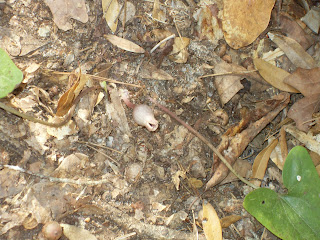You won't believe this, but on Tuesday I visited the Pike County Pocosin for the second time. Who would have thought. lol! (Read about my previous experience http://gardeningalabama.blogspot.com/2010/11/trip-to-pocosin.html ) This round, there were about 20 people in our group, and we were guided by one Dr. Barger, an Alabama State Conservationist. This time I was prepared. I wore my pink galoshes, tough jeans, garden gloves, tons of bug patches under my long-sleeved lightweight coat (in 80+ F weather) and a wide brim hat. For sure I was protected from the elements and prickly flora. However, I was wide open to any potential wildlife we'd encounter. I half-joked about borrowing a shotgun from a friend to ward off snakes, but she wisely turned me down. Then I thought about taking a machete, but eventually decided against it. I figured the last thing people would want is me wielding a weapon near their limbs while running for my life. Thankfully, the snakes stayed away. And I nestled comfortably in the middle of the group so I wouldn't be the first or the last person the snakes saw.
As with the last trip, I enjoyed seeing many interesting things I probably wouldn't get the opportunity to see otherwise. In the Pocosin basin, we walked along a creek. I love the sound it created. Very peaceful. Almost made me forget about snakes. Almost. (Renewed my interest in creating a water feature in my yard though, but I digress.)
Also along the creek, we spotted Crane Fly Orchids. I was taken with the two-toned leaves; green on the top and purple on the bottom. Very unusual. We also saw last year's seed pods. Unlike most flowering perennials, these seeds were minute, even smaller than grains of sand. Too bad they were not in bloom.
Of course I googled their image the second I came home (and took a shower).
http://www.carrborocitizen.com/main/2008/08/14/rescuing-cranefly-orchids-from-english-ivy/
Image by Dave Otto.
Something I would have totally missed were male flower of the wild ginger plant, also known as something brown pod. (If you're reading this, and you were there, please fill in the blank for me.) The first picture shows the pod closed and the second shows it open. The only way to find one, is to look for the smilac-looking groundcover leaves and dig around, usually under inches of rotted mulch, to spot it. It was amusing watching adults digging in the woods with childlike energy, myself included.
Red Buckeye and Bloodroot are two other plants that stood out. I was able to take a picture of the former, which is beautiful for its red flowers. Bloodroot however, 'bleeds' from the stem when you pick a leaf. As I was too busy gawking, I forgot to take a snapshot. To see the latter, click on the following link:
http://www.ottawahort.org/2008bloodroot.htm
As far as trees, the Beach Tree was a big hit for me. Its leaves were just beginning to emerge. They are initially covered in some type of golden cocoon which look like spikes. However, the Arizona Oak seemed to be the tree to see. It's a rare species of oak in North America and the group clamored to find one. Unfortunately the leaves have not yet emerged, making it difficult to distinguish it from other oaks. While most in the group were a little disappointed, they recovered quickly once Dr. Barger pointed out dry Arizona Oak leaves on the ground. These were then passed around with gusto. Again, a little amusing.
An hour and a half later, we were done. I survived yet another hike through the Pocosin without spotting any snakes. How about that?!? Again, a great learning experience. I'll have to work on the DH now and convince him to go on the next hike. I'm looking forward to that blog entry.




No comments:
Post a Comment